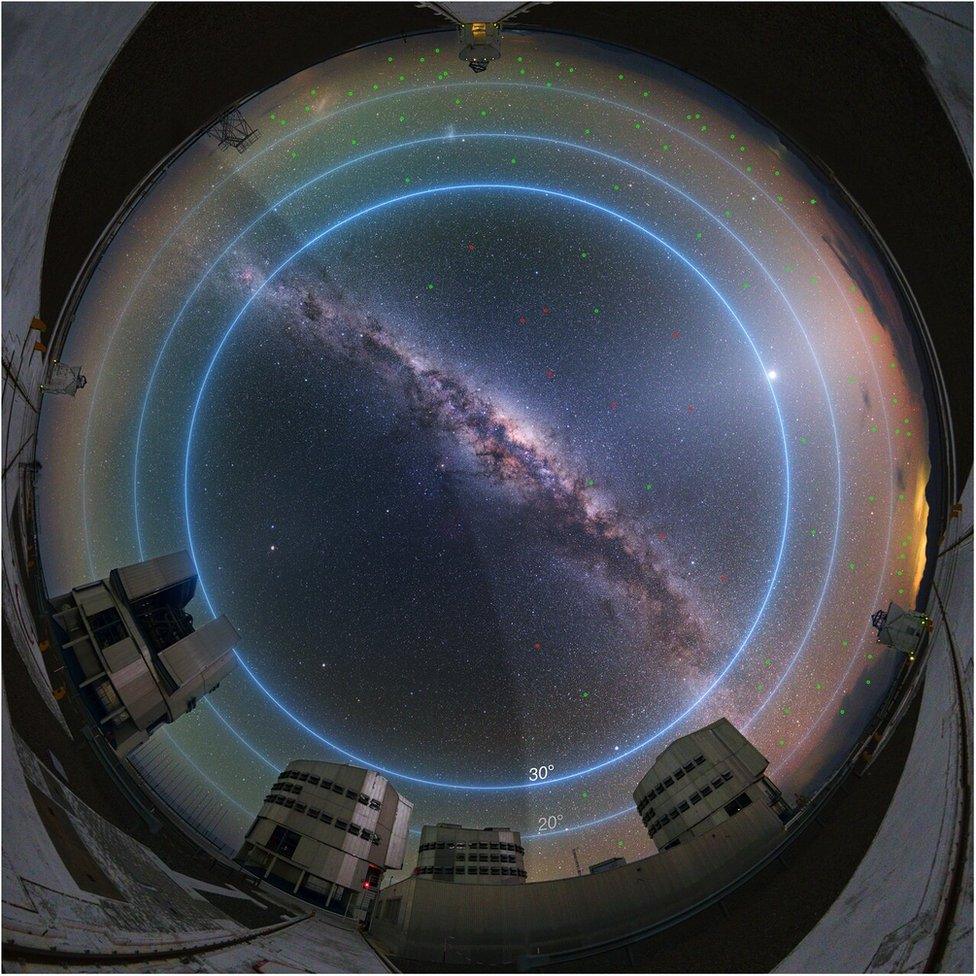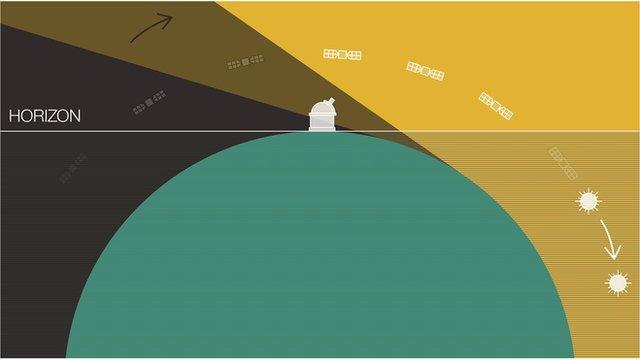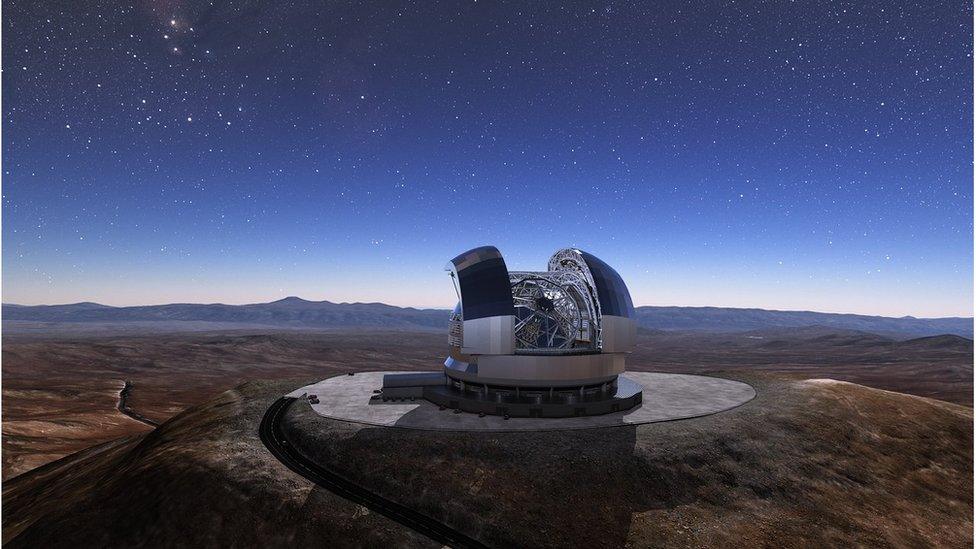Europe's major telescopes 'can meet satellite challenge'
- Published
- comments

Elevation on the sky at the VLT in Chile: Most visible satellites will be below 30 degrees

Europe's flagship telescopes will be "moderately affected" by the new satellite mega-constellations now being launched, according to a new study.
Having thousands more bright objects in the sky will create inconvenience and extra cost, but the idea that astronomy faces some kind of a "cliff edge" is not correct, says Olivier Hainaut.
He's calculated how observing time might be limited by having 26,000 additional spacecraft in orbit.
And it's manageable, he believes.
Dr Hainaut works for the European Southern Observatory (ESO) organisation which operates world-class facilities in Chile's Atacama Desert, including the VLT (Very Large Telescope) and the forthcoming Extremely Large Telescope (ELT).
Neither is likely to be deeply troubled by the wave of new broadband satellites being launched by companies such as SpaceX of California and London-based OneWeb.
"We will lose some telescope time due to the satellites crossing the field of view. For us, for ESO telescopes, this is something that we can mitigate by scheduling, and by 'closing the shutter' when they pass overhead," Dr Hainaut told BBC News.
"It has a cost, of course; we would need to develop the software to compute the positions of the satellites, etc. That's not horribly complicated, but it will need to be done."
His study, co-authored with Andrew Williams, has been accepted for publication in the journal Astronomy & Astrophysics, external.
A time-lapse of the Starlink satellites taken from the Peak District
It was prompted by the furore that followed the initial launches last year of 60-at-a-time "Starlink" satellites from SpaceX.
The internet platforms shocked many with their brightness; astronomers complained of streaks in their telescope images. And with thousands more spacecraft in the planning, scientists feared the full roll-out of large constellations might seriously compromise their observations of the cosmos.
The ESO study attempts to make a calm forecast of the likely impacts. It necessarily follows some assumptions about the networks' scale and distribution, and the reflectivity of individual spacecraft. But for arguments' sake, it imagines there will be 18 orbiting constellations comprising 26,000 satellites.
For this scenario, the research reveals there would be about 1,600 illuminated spacecraft in view (above the horizon) of a mid-latitude observatory like the VLT or the ELT. The vast majority of these spacecraft, however, would be low in the sky; and above 30 degrees — that portion of the sky where most observations occur — there would be only about 250 satellites at any given time.
Up to about 100 satellites could potentially be bright enough to be visible with the naked eye during twilight hours, about 10 of which would be higher than 30 degrees of elevation.
All these numbers fall off sharply as more of the sky moves into the shadow of the Earth in the middle of the night.

The situation improves as the satellites above the horizon move into Earth's shadow
Short exposures on ESO's narrow-field observatories like the VLT and ELT should cope in this scenario.
"For a 100-second exposure time at twilight, we would lose 0.3% of the exposures. So, that means for every 1,000 exposures we take, three of them would be ruined by a satellite. And that number goes down as the Sun goes down," Dr Hainaut explained.
But there are facilities, he concedes, that will be greatly affected. These are the ones dedicated to long exposures on wide fields of view.
The example citied is the upcoming NSF Vera C Rubin Observatory (formerly called the Large Synoptic Survey Telescope).
This will be attempting to draw a map of the entire sky every three days. Its wide field of view and remarkable sensitivity to anything that's moving in sight of its detectors will make Vera Rubin especially vulnerable to interference.
If no mitigating strategy is introduced for this telescope, up to 40% of its imagery at twilight hours could be unusable.

The ELT will be the largest optical telescope in the world when it comes online this decade
For ESO, its greatest concern centres on the Vista telescope. This is a wide-field observatory that was paid for by the UK when it joined the organisation in 2002.
It's about to be fitted with a new fibre-optic spectroscopic camera, able to capture the detailed colours of 2,400 objects simultaneously, over an area on the sky equivalent to 20 full Moons.
In the worst case, up to 30 fibres could be affected by a satellite trailing across the sky.
"Once you crunch the numbers, the numbers are not as bad as what some people feared," Dr Hainaut told BBC News. "People said 'oh no, there'll be 40,000 bright satellites in the sky? No, there won't be, simply because most of these satellites will be below the horizon, and then most of the others will be in the shadow of the Earth. That's the first bit of good news.
"The second bit of good news is that the space industry, and specifically Space X and OneWeb are talking to us. They are really listening."
The two companies have promised to work with the astronomical community to limit the interference as much as possible.
Hainaut and Williams' study only concerned itself with optical/infrared telescopes. Radio telescopes will face a separate challenge of interference if the mega-constellation internet satellites transmit outside their designated wavelength bands.
And Dr Hainaut goes out of his way to stress the limitations imposed on the study by the assumptions made.
For example, today no-one really knows how many satellites will be launched. It could be less than 26,000; it could be substantially more. Problems will certainly scale if there are more.
And no-one knows just how bright the different designs of spacecraft will be. For this paper, each object is treated as a representative sphere.

Vera Rubin: It's the wide-field observatories that will have more of a problem
Jonathan.Amos-INTERNET@bbc.co.uk, external and follow me on Twitter: @BBCAmos, external